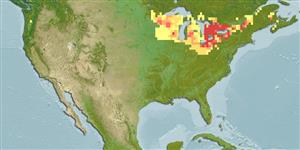Classification / Names
Common names | Synonyms | Catalog of Fishes (gen., sp.) | ITIS | CoL | WoRMS | Cloffa
Actinopterygii (ray-finned fishes) >
Cypriniformes (Carps) >
Cyprinidae (Minnows or carps) > Leuciscinae
Etymology: Clinostomus: Greek, klinein, kline = sloping and bed, due to the four apophyses of sphenoid bone + Greek, stoma = mouth (Ref. 45335).
Environment / Climate / Range
Ecology
Freshwater; demersal. Temperate, preferred ?; 44°N - 38°N
North America: Hudson and upper Susquehanna River drainages in New York and Pennsylvania, USA; Great Lakes (except Lake Superior) and Mississippi River basins from New York in USA and south Ontario in Canada to Minnesota and south to West Virginia and Kentucky in USA.
Size / Weight / Age
Maturity: Lm ? range ? - ? cm
Max length : 12.0 cm TL male/unsexed; (Ref. 86798); common length : 8.9 cm TL male/unsexed; (Ref. 12193); max. reported age: 4 years (Ref. 12193)
Distinguished from similar species Cinostomus funduloides by having longer, more pointed snout, more slender body, brighter (carmine) red on lower side in adults; smaller (59-75 lateral) scales. Breeding male possess steel blue above, yellow-gold stripe along side, bright red on lower side (Ref. 86798).
Inhabits rocky and sandy pools of headwaters, creeks and small rivers. Largest populations occurs in clear, spring-fed streams (Ref. 86798).
Life cycle and mating behavior
Maturity | Reproduction | Spawning | Eggs | Fecundity | Larvae
Page, L.M. and B.M. Burr, 2011. A field guide to freshwater fishes of North America north of Mexico. Boston : Houghton Mifflin Harcourt, 663p. (Ref. 86798)
IUCN Red List Status (Ref. 115185)
CITES (Ref. 94142)
Not Evaluated
Threat to humans
Harmless
Human uses
More information
ReferencesAquacultureAquaculture profileStrainsGeneticsAllele frequenciesHeritabilityDiseasesProcessingMass conversion
Tools
Special reports
Download XML
Internet sources
